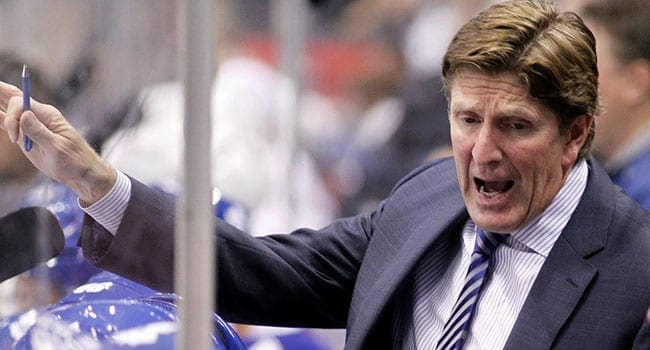 On his voyage from coaching sage to the most ignorant coach to ever stand behind a National Hockey League bench, Mike Babcock learned a few important things.
On his voyage from coaching sage to the most ignorant coach to ever stand behind a National Hockey League bench, Mike Babcock learned a few important things.
Principally, he learned that a coach’s job security is governed by winning. If you don’t win, you will be replaced. No news there.
But he also understood that if ownership had invested in you at great cost and term of service, then your chances of outlasting the grim reaper were enhanced. For that reason, Babcock drove the hardest of bargains when the desperate Toronto Maple Leafs came calling for a new coach in 2014.
He told Toronto president Brendan Shanahan that if the Leafs were to extract him from Detroit – where he’d coached for 10 years with one Stanley Cup and 581 wins – it was going to take an eight-year contract at $6.25 million a season. (The previous record salary for a coach was less than half that.)
Babcock unapologetically announced he was going to set the bar for all NHL coaches with this deal, giving them security and, most importantly, authority in the dressing room with petulant stars.
For the cash-rich Leafs – who’d spent much of that decade wallowing in awfulness – no price was too high to buy the respectability they craved. Their offer knocked Buffalo, St. Louis and San Jose out of the bidding. And so, with much pomp and circumstance, Babcock was hired as the 30th head coach of the Leafs, the man who was going to lead the Buds to the promised land.
It didn’t take long before the stories emerged about players chafing under Babcock’s regime. He was not communicative enough, unable to adapt to a new style of play in the NHL and probably had body odour as well. But the commitment of Toronto management and the enormous buyout of his contract stilled the insurrection.
So long as Toronto owed him a big payout, management was willing to bide its time with a coach who’d won two Stanley Cups, two Olympic gold medals and multiple titles at other levels of the sport. Plus, they knew their influx of talented prospects – Auston Matthews, Mitch Marner, William Nylander, Nikita Zaitsev – would be properly schooled in the rigours of NHL life.
After missing the post-season in year one of the Babcock regime, the team made the playoffs three years in a row. But with each succeeding loss in the opening round, pressure grew that Babcock was stifling the talent. His hard-ass routine that worked in the past was reportedly unsuited to the new generation of stars. Stories emerged that players hated him.
Still, his massive contract bought him time. Would the Leafs actually pay a coach $20 million not to coach?
So, while the media mob and social media bayed for Babcock’s scalp, he played steady-as-she-goes with his coaching philosophy.
The death knell for Babcock came not on the ice but in the office of second-year general manager Kyle Dubas, a callow phenom who won a power struggle over Mark Hunter to be the GM. It fell to Dubas to negotiate the second contracts of his young stars, Matthews, Marner and Nylander.
With veteran John Tavares already drawing $11 million a season until 2025, the budget seemed to demand belt tightening. Instead Toronto inked Matthews to a deal that pays him $11 million until 2024, Nylander a contract that brings him just under $7 million until 2024 and Marner just under $11 million until 2025. Added to goalie Frederik Andersen’s $5 million, it was a top-heavy roster that demanded superlative value from the featured players.
With so much guaranteed to just five contracts, Babcock was left to fashion a two-tier strategy that prayed for a hot goalie and a bargain-level defence. Neither ever emerged.
But Babcock’s ultimate Achilles heel – one he shares with a number of NHL coaches – was how to motivate 20-somethings who have job security until the middle of the next decade?
A good deal of the criticism following Babcock’s firing was the indifference of his young stars on many nights. Matthews, who was denied the captaincy after a brush with the law in his hometown of Phoenix this summer, has seemed bored in many games.
There’s a similar battle of wills between coach and high-paid 20-something stars happening in Calgary. Bill Peters – who doesn’t have a massive contract to protect him – is being hung out to dry by his stars Johnny Gaudreau and Sean Monahan, who have long-term guaranteed contracts that extend well into the next decade. Calgary broke a six-game losing streak on Saturday, but Peters (another traditional coach) is still on the hot seat.
While Edmonton has played much better so far under new coach Dave Tippett, the top-heavy salary structure going to 20-somethings is a factor there, too.
League commissioner Gary Bettman’s precious collective bargaining agreement was not meant to reward players this early, but the market destroyed that triumph of the lockouts.
Which begs the question: who goes first to correct the situation?
Players carrying contracts in the range of $6 million to $12 million a year are not easy to trade. Plus fans are not happy when their favourites are moved.
As Babcock well understood, the easiest piece to remove is the coach.
It’s an equation that we will see repeated numerous times until Bettman shuts down the league again to make his salary cap work.
Troy Media columnist Bruce Dowbiggin career includes successful stints in television, radio and print. A two-time winner of the Gemini Award as Canada’s top television sports broadcaster, he is also the publisher of Not The Public Broadcaster.
The views, opinions and positions expressed by columnists and contributors are the author’s alone. They do not inherently or expressly reflect the views, opinions and/or positions of our publication.


